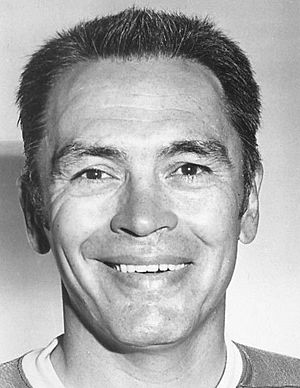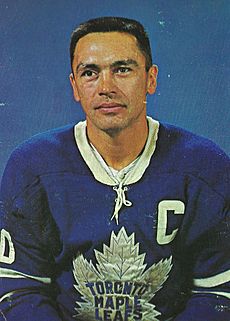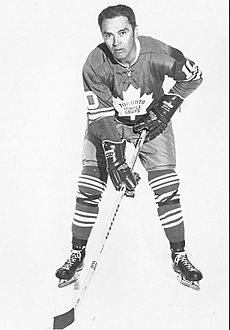George Armstrong (ice hockey) facts for kids
Quick facts for kids George Armstrong |
|||
|---|---|---|---|
| Hockey Hall of Fame, 1975 | |||

Armstrong with the Toronto Maple Leafs in 1970
|
|||
| Born | July 6, 1930 Skead, Ontario, Canada |
||
| Died | January 24, 2021 (aged 90) Toronto, Ontario, Canada |
||
| Height | 6 ft 2 in (188 cm) | ||
| Weight | 185 lb (84 kg; 13 st 3 lb) | ||
| Position | Right wing | ||
| Shot | Right | ||
| Played for | Toronto Maple Leafs | ||
| Playing career | 1949–1971 | ||
George Edward Armstrong (born July 6, 1930 – died January 24, 2021) was a Canadian professional ice hockey player. He played as a centre for 21 seasons in the National Hockey League (NHL). All of his games were with the Toronto Maple Leafs.
Armstrong played an amazing 1,188 NHL games between 1950 and 1971. This is still a record for the Maple Leafs team! He was also the team's captain for 13 seasons. George Armstrong helped the Maple Leafs win the Stanley Cup four times. He also played in seven NHL All-Star Games. He scored the very last goal of the NHL's "Original Six" era when Toronto won the Stanley Cup in 1967.
Before playing professionally, Armstrong played junior and senior hockey for the Toronto Marlboros. He even helped them win the 1950 Allan Cup. After his playing career, he coached the junior Marlboros team to two Memorial Cup championships. He also worked as a scout for the Quebec Nordiques. For a short time in the 1988–89 season, he was even the head coach for the Maple Leafs. Armstrong was added to the Hockey Hall of Fame in 1975. The Maple Leafs honoured his jersey number 10 in 1998 and officially retired it in 2016.
Contents
Early Life and First Steps in Hockey
George Armstrong was born in 1930 in Skead, Ontario. His father was Irish Canadian, and his mother was Algonquin. George grew up in Falconbridge, Ontario, where his father worked as a miner. Sports were important in his family. His dad played soccer, and his mom was a great canoeist.
George loved hockey, but he wasn't a natural skater at first. His father thought this might be because George had spinal meningitis when he was six years old. While attending Sudbury High School, George played hockey with future NHL stars Red McCarthy and Tim Horton. He saw an ad for tryouts with the Copper Cliff Redmen and convinced his friends to join him.
He started his junior hockey career at age 16 in the 1946–47 season. He quickly caught the eye of scouts from the Toronto Maple Leafs. The Maple Leafs added him to their list of protected players. Armstrong decided to leave school in grade 11 to focus on his hockey dream.
Playing Career Highlights
Junior and Senior Hockey Success
The Maple Leafs sent Armstrong to play for the Stratford Kroehlers in the Ontario Hockey Association (OHA) junior league for the 1947–48 season. He was amazing, leading the league in assists and points. He even won the Red Tilson Trophy as the OHA's most valuable player.
In 1948–49, he moved to the Toronto Marlboros junior team. He then played for the senior Marlboros team in 1949–50, where he became their captain. He set an OHA record with 64 goals that season and scored 115 points in just 39 games. He won the Red Tilson Trophy again!
Armstrong played two games for the Maple Leafs in December 1949, making his NHL debut. He then returned to the Marlboros. In 1950, he helped the Marlboros win the 1950 Allan Cup, which is the national senior championship. It was during this time that he got his famous nickname, "Chief." When visiting a Stoney Reserve in Alberta, locals gave him a special headdress and called him "Big Chief Shoot the Puck" because of his Native heritage. This was often shortened to "Chief."
Becoming a Maple Leaf Star
In the 1950–51 season, Armstrong turned professional and played for the Pittsburgh Hornets, Toronto's minor league team. He was a top scorer despite injuries. In the 1951–52 season, he was called up to the Maple Leafs and scored his first NHL goal. This was a special moment, as it was the first goal ever scored by a player with Native heritage.
By the 1952–53 season, Armstrong earned a permanent spot with the Maple Leafs. He became a key player, scoring more points each year. He was named to the NHL All-Star Game in both 1956 and 1957. These were the first two of seven All-Star Games he would play in!

In the 1957–58 season, the Maple Leafs made Armstrong their captain. He led the team to the 1959 Stanley Cup Final and 1960 Stanley Cup Final, but they lost to the Montreal Canadiens both times.
Stanley Cup Champion!
The Maple Leafs finally reached the top in the 1961–62 season. Armstrong had his best season yet with 53 points. He played a big part in the winning goal of the Stanley Cup final game against the Chicago Black Hawks. As captain, Armstrong proudly accepted the trophy.
This was the first of three Stanley Cups in a row for Toronto, making them a true hockey dynasty from 1962 to 1964. Armstrong continued to score many goals during these championship years. He also played in his fourth, fifth, and sixth All-Star Games during this time. On December 1, 1963, he scored his 200th career NHL goal.
In the 1966–67 season, the Maple Leafs were not expected to win. They were seen as the underdog against a very strong Chicago team. But the Maple Leafs surprised everyone, beating Chicago and then facing Montreal in the 1967 Stanley Cup Final. Montreal was so sure they would win that they even set up a display for the Stanley Cup at Expo 67 before the series started!
But the Maple Leafs crushed Montreal's hopes by winning the championship in six games. Armstrong scored the final goal of the series in a 3–1 victory. This was also the very last goal scored in the NHL's "Original Six" era, as the league was about to double in size to 12 teams.

Armstrong thought about retiring after this big win, but he kept playing for a few more seasons. He played in his seventh All-Star Game in 1968. He finally ended his amazing playing career after the 1970–71 season. He finished with 296 goals, just four short of 300. At the time he retired, he was one of the longest-serving team captains in NHL history.
Coaching and Scouting Career
After retiring as a player, Armstrong became the head coach of his old junior team, the Toronto Marlboros, in 1972. Even though he preferred being a scout, he led the Marlboros to win the Memorial Cup twice, in 1973 and 1975.
Later, Armstrong returned to the Maple Leafs organization as an assistant general manager and scout. During the 1988–89 season, he even stepped in as the head coach for part of the season. He continued to work as a scout for the Maple Leafs for the rest of his life.
Playing Style and Legacy
The Toronto Maple Leafs described George Armstrong as a "consistent, durable and hardworking" player. He played for 21 seasons, covering parts of four decades! He was a true leader. The team's owner, Conn Smythe, once called him "the best captain, as a captain, the Leafs have ever had."
When he retired, his 713 career points were the second most in Maple Leafs history. He still holds the record for most games played (1,187) and most assists (417) and points (713) by a right wing for the Maple Leafs. In 1959, he won the J. P. Bickell Memorial Award for his excellent performance. In 1998, the Maple Leafs honoured his uniform number 10.
Armstrong was inducted into the Hockey Hall of Fame in 1975 and the Ontario Sports Hall of Fame in 2010.
Personal Life
George Armstrong lived in the Leaside neighbourhood of Toronto for over 55 years. He loved spending time with his family, often going bike riding. Besides coaching professional hockey, he also coached community sports teams. He even helped coach the first floor hockey team for the Canadian Special Olympics.
George lived in Toronto with his wife, Betty. They had four children: Brian, Betty-Ann, Fred, and Lorne. His nephew, Dale McCourt, was also a professional hockey player. Another nephew, Dan McCourt, was an NHL referee for many games.
In 2005, when he had a day with the Stanley Cup, Armstrong chose to have a family gathering at his son's home. His granddaughter, Kalley, was a team captain for the Harvard Crimson women's ice hockey team.
Armstrong was recognized for his charity work in 1969 when he received the first-ever Charlie Conacher Humanitarian Award. He was very proud of his Native heritage and often supported programs that helped promote positive role models for Native children.
George Armstrong even had a small role in a movie! He appeared as himself in the 1971 film Face-Off.
George Armstrong passed away on January 24, 2021, at the age of 90, after suffering from heart problems.
Awards and Honours
- Red Tilson Trophy: 1947–48, 1949–50
- Allan Cup champion: 1949–50
- Played in the NHL All-Star Game: 1956, 1957, 1959, 1962, 1963, 1964, 1968
- J. P. Bickell Memorial Award: 1959
- Stanley Cup champion: 1961–62, 1962–63, 1963–64, 1966–67
- Charlie Conacher Humanitarian Award: 1968–69
- Memorial Cup champion: 1973, 1975 (as coach)
Images for kids
-
Armstrong with the Toronto Maple Leafs in 1970
-
Armstrong with the Maple Leafs during the 1970–71 season. He retired at the end of that season.




